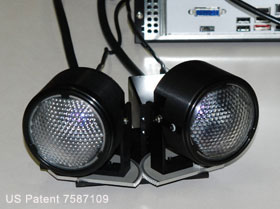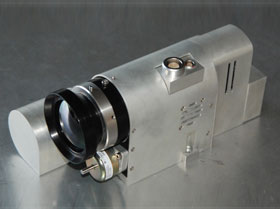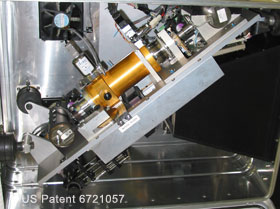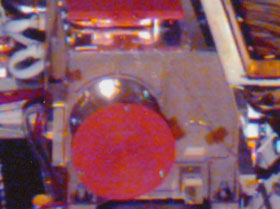
Artificial compound eyes
Artificial Compound Eyes (ACE) are new cameras that enable high resolution, wide angle images to be generated without distortion. The optics have an infinite depth of field, so objects remain in focus at any distance without the need for focus adjustment. The entrance pupil is divided across hundreds of apertures, so the image intensity remains constant across the field. Hundreds of field stops block stray light, thereby enabling cameras (such as star trackers) to view within a few degrees of the sun. SPILAB began its ACE research in 2004 by studying the eyes of moths and beetles. In 2005 the Air Force Research Lab at Eglin AFB funded the development of the first superposition ACE. The work continued in 2008-2009 with the development of the first hybrid, superposition-apposition ACE shown on the left, and it continues in 2010 with funding by DARPA.

Infrared Cameras
SPILAB began work on cryo-cooled infrared cameras in 2003 with the development of the Miniature Infrared Camera (MIRCAM). The project was funded by Eglin AFB to replace a small, visible wavelength camera within the test pod of a F-16 Fighting Falcon. The space was extremely limited, so the infrared replacement camera needed to be significantly smaller than existing cryo-cooled cameras. The MIRCAM prototype is shown on the left with its 48 mm lens.

Laser Emission Spectrometers
SPILAB has been involved in the development of laser emission spectrometers since 2002. The first such spectrometer was the Thermal Infrared Surface Contamination Sensor (TIRSCS) shown on the left. This was developed for stand-off detection of low vapor pressure surface contaminants, such as nerve agents. The prototype was delivered to the Army at Aberdeen Proving Ground. The TIRSCS is based on a novel anamorphic spatial interferometer - Fourier transform spectrometer using a small beam-shearing prism. SPILAB has also developed a new type of laser induced breakdown spectrometer (LIBS). The new LIBS is also based on an anamorphic spatial interferometer, but of a different design than the TIRSCS. The new LIBS enables a single Fourier transform spectrometer and a single detector array to perform the same function as seven grating spectrometers with seven sets of detector arrays.

Offner Imaging Spectrometers
SPILAB developed a small palm sized Offner imaging spectrometer in 2002 based on previous designs that have flown on several space missions. The spectrometer uses a convex diffraction grating in an Offner relay to enable symmetry to cancel aberrations that typically plague other low F/#, long slit imaging spectrometrers. The first Offner spectrometer was the Visible Infrared Mapping Spectrometer (VIMS), developed in 1992 and later launched in 1997 on the Cassini spacecraft to orbit Saturn and its moons. The second Offner spectrometer was the Rosetta Visible Infrared Thermal Imaging Spectrometer (VIRTIS), developed in 1995 but not launched until 2004. The Rosetta mission is to rendezvous with a comet and follow it back toward the sun to measure the evolution of the comet's tail. The third Offner spectrometer was the spare VIRTIS that was eventually launched onboard Venus Express.
